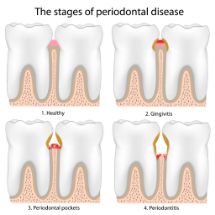 Did you know that an estimated 65 million adults in the U.S. have some form of gum disease? Many people underestimate the importance of gum health, but it’s actually crucial for several reasons. First, gum disease is the leading cause of tooth loss. And it’s also been found to increase the risk of many serious diseases like Alzheimer’s, heart disease, diabetes, stroke, and even some cancers. Keep reading to find out what causes gum disease and how regular visits with a dentist are all that’s necessary to diagnose and treat it!
Did you know that an estimated 65 million adults in the U.S. have some form of gum disease? Many people underestimate the importance of gum health, but it’s actually crucial for several reasons. First, gum disease is the leading cause of tooth loss. And it’s also been found to increase the risk of many serious diseases like Alzheimer’s, heart disease, diabetes, stroke, and even some cancers. Keep reading to find out what causes gum disease and how regular visits with a dentist are all that’s necessary to diagnose and treat it!
What Causes Gum Disease?
Gum disease, also called periodontal disease, can be caused by any of the following:
- Poor oral hygiene (this is the most common cause)
- Heredity
- Smoking
- Diabetes
- Certain medications (e.g. blood pressure, seizure, or immunosuppressant drugs)
Symptoms to look for include bleeding, swollen, or tender gums, bad breath, and gum recession. However, since gum disease isn’t usually painful until advanced stages, it’s important to get regular checkups to have your gums monitored.
How Is Gum Disease Diagnosed?
A periodontal exam is very simple and usually takes about 10-15 minutes. Either a dentist or hygienist will use an instrument that’s similar to a ruler (marked in millimeters) to measure the “pockets” around each tooth. Normal pocket depths are 1-3mm, which are shallow enough to keep clean with simple brushing and flossing.
Pockets deeper than 4mm indicate the presence of gum disease. At this depth, your toothbrush and floss can’t reach or remove the plaque under the gumline, so bacterial accumulation leads to inflammation or infection of the gums. Over time, the pockets become even deeper and it turns into a vicious cycle.
With regular screenings, gum disease can be found as early as possible, when treatment is most effective.
How Is Gum Disease Treated?
In most cases, the first recommendation for periodontal therapy is scaling and root planing, also called a deep cleaning with local anesthetic. It’s usually done in 2-4 visits, before which you’ll be numbed for comfort. Then a hygienist will thoroughly remove tartar and bacteria from under the gumline and smooth the roots to prevent bacteria from re-accumulating. You’ll also get personalized oral hygiene tips, which are very important for managing gum disease between visits.
Another treatment option, typically done immediately after a deep cleaning, is a topical antibiotic that’s placed directly under the gumline. This antibiotic “gel” directly targets and kills microscopic bacteria (the source of the problem), and is a wonderful complement to scaling and root planing.
For severe cases, you may be referred to a gum specialist called a periodontist for further evaluation and possible gum surgery.
Although gum disease impacts your oral and overall health in serious ways, your risks can be minimized or avoided altogether with early diagnosis and treatment.
About the Author
Dr. Darren Koch is a general, cosmetic, and restorative dentist with nearly 20 years of experience. He understands how vital gum health is to his patients’ well-being and focuses on prevention and early treatment to help them minimize the risks associated with gum disease. If you have any questions about your gums, he can be reached via his website.






